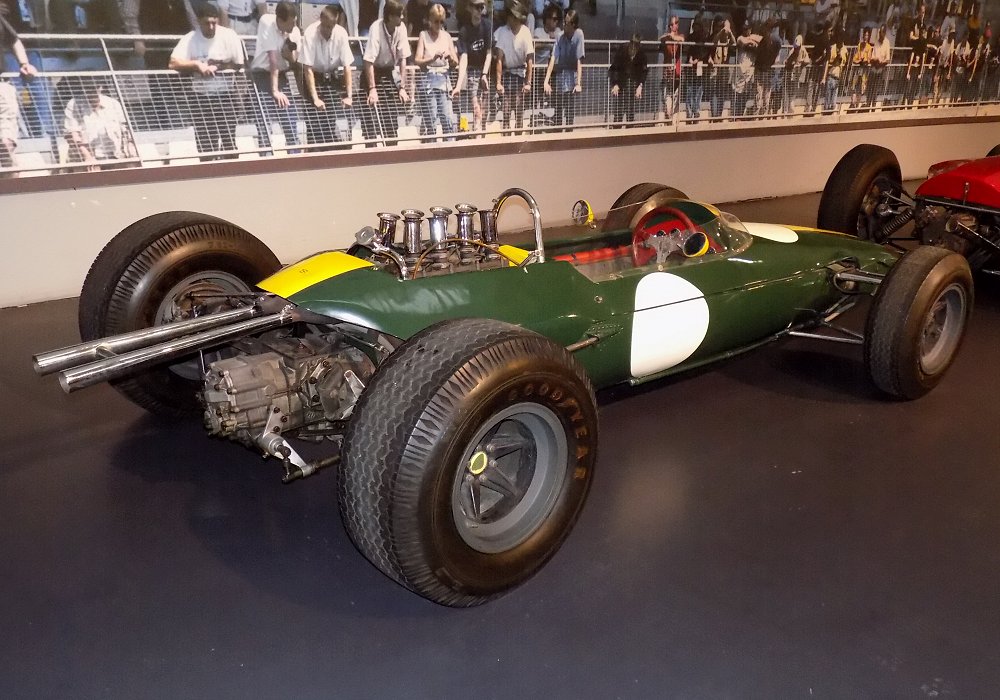Description
The Lotus 33, introduced in 1964, was one of the most successful and beautifully balanced Formula One cars of its era. It represented the full maturation of Colin Chapman’s monocoque philosophy, building directly on the revolutionary Lotus 25 of 1962 but refining it into a stronger, stiffer, more competitive machine. With the 33, Lotus perfected the essential Formula One layout of the 1960s: a fully stressed aluminium monocoque, a compact V8 engine as a structural component, and suspension geometry designed for precision and stability at extreme speeds.
The Lotus 33 retained the same basic concept as the Lotus 25, but almost every detail was improved. The monocoque chassis, constructed from riveted and bonded aluminium sheet, was widened and stiffened to increase torsional rigidity. The fuel tanks were housed within the side pontoons for optimal weight distribution, and the cockpit was slightly enlarged to give drivers a more comfortable seating position — an important consideration in longer Grand Prix races. Chapman and his engineers refined the design to produce a chassis that was strong enough to cope with modern racing speeds, while maintaining the lightness that defined every Lotus Grand Prix car of the period.
Power came from the Coventry Climax FWMV 1.5-litre V8 engine, installed as a semi-stressed member of the chassis. In its 1964–65 specification, the engine produced around 200–210 horsepower at nearly 10,000 rpm — a remarkable figure for such a small displacement. The engine’s compact dimensions and light weight made it ideal for the 33’s sleek, narrow design. It was paired with either a five-speed ZF or Hewland transaxle, both offering close ratios and smooth, precise shifting.
Suspension design was one of the car’s greatest strengths. At the front, unequal-length double wishbones with coil springs and dampers provided excellent steering response and stability. At the rear, Chapman used lower wishbones, twin radius arms, and an upper link, creating a layout that maintained optimal camber and traction even under heavy acceleration and cornering loads. Girling disc brakes were fitted at all four corners, and the steering was light, direct, and highly communicative. The Lotus 33 handled with both delicacy and confidence — agile and responsive, yet stable at high speeds and forgiving at the limit.
Aerodynamically, the 33 refined the clean, cigar-shaped bodywork introduced on the Lotus 25. The profile was extremely low and narrow, with minimal frontal area and perfectly smooth lines from nose to tail. The aluminium panels were shaped with precision to reduce drag and ensure stability. This uncluttered, elegant shape became iconic, representing the purest form of 1960s Grand Prix car design before wings and downforce began to reshape the sport.
The Lotus 33 made its competitive debut during the 1964 season, and it was immediately clear that it was a front-running car. Jim Clark, already the reigning World Champion, used the 33 to win the Belgian, Dutch, and British Grands Prix. Mechanical issues cost him the 1964 title, but the car was arguably the fastest of the season.
It was in 1965, however, that the Lotus 33 achieved true greatness. With improved reliability and further refinements to suspension and engine tuning, Clark dominated the season. He won six of the ten Championship Grands Prix — South Africa, Belgium, France, Holland, Britain, and Germany — securing his second World Drivers’ Championship with remarkable calm and precision. Team Lotus also claimed the Constructors’ title, cementing the 33’s place as one of the most successful cars in Formula One history.
Beyond the World Championship, the 33 also achieved success in non-championship events and influenced the design of countless subsequent Grand Prix cars. Its blend of structural integrity, lightness, and aerodynamic purity set a new standard that other constructors were forced to follow.
Only a handful of Lotus 33 chassis were built — generally understood to be six — and each was constantly updated throughout its racing life, making exact specifications differ between cars and seasons.
Visually, the Lotus 33 remains one of the most iconic cars of the 1960s. Its long, slender proportions and minimalist form capture the essence of Chapman’s design ethos: reduce weight, reduce drag, reduce complexity — and allow the driver’s skill to shine.
Today, the Lotus 33 is remembered not only as a technical masterpiece but also as one of the greatest drivers’ cars ever built. It delivered Jim Clark one of his most dominant seasons and demonstrated just how advanced Lotus engineering had become. In many ways, the 33 represents the peak of the 1.5-litre Formula One era — the moment when engineering elegance, driver talent, and Chapman’s relentless innovation fused into a near-perfect Grand Prix machine.


